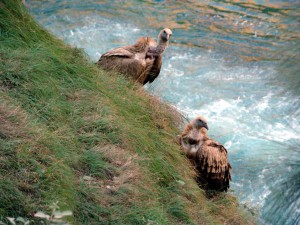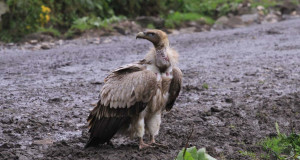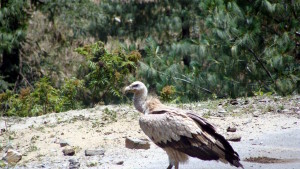
Gyps himalayensis (Griffon vulture)
The Griffon Vulture (Gyps himalayensis) is one of the most iconic and majestic raptors soaring above the Great Himalayan National Park (GHNP). As the largest vulture species found in the Himalayas, this bird plays a vital ecological role as a scavenger, helping to keep the mountain ecosystem clean and balanced. Its presence is often a highlight for birdwatchers exploring the park’s rugged terrains and high cliffs.
Physical Characteristics and Identification
The Griffon Vulture is a massive bird, with a wingspan ranging from 2.5 to nearly 3 meters, making it a spectacular sight as it glides effortlessly across the skies. Its pale brown body, contrasting with a white ruff around the neck and dark flight feathers, makes it easily distinguishable from other large birds in GHNP. The bird’s bare head and neck are evolutionary adaptations that help with hygiene while feeding on carrion.
Habitat and Distribution in GHNP
Within the Great Himalayan National Park, the Griffon Vulture is typically found at elevations between 2,000 and 4,500 meters. It prefers open cliffs and rocky ledges for roosting and nesting, often spotted circling above remote valleys such as Tirthan, Sainj, and Jiwa Nal. These high-altitude areas provide the seclusion and food availability essential for the vulture’s survival.
Behavior and Feeding Habits
Griffon Vultures are scavengers that feed exclusively on carrion, particularly dead ungulates like Himalayan tahr, goral, and livestock that may die in the harsh mountain terrain. These vultures often gather in large numbers at carcasses, using their strong beaks to tear through tough hides. They are non-aggressive feeders and rely on sight to locate food, soaring great distances daily in search of it.
| Common name | Himalayan Griffon Vulture |
| Scientific name | Gyps himalayensis |
| Family | Accipitridae |
| Description | It is a resident bird of Himalayas, having broader body and slightly longer tail. The wings coverts and body is pale buffish-white, contrasting strongly with dark flight feather and tail; underparts lack pronounced streaking; legs and feet pinkish with dark claws. It is found in an altitude of 600-5000m in Himachal Pradesh. |
Ecological Importance
As natural cleaners of the ecosystem, Griffon Vultures play a crucial role in disease control by disposing of decomposing animal matter. This reduces the risk of disease spread among both wildlife and human communities. Their population health is a direct indicator of the state of the high-altitude food web and biodiversity in GHNP.
Conservation Status
Although listed as Least Concern globally, regional threats such as poisoning from veterinary drugs (e.g., diclofenac), habitat disturbance, and food scarcity have impacted vulture populations across South Asia. However, within GHNP, the species finds refuge thanks to the park’s legal protection, low human interference, and healthy populations of wild ungulates.
Conclusion
The Griffon Vulture (Gyps himalayensis) is a powerful symbol of the high Himalayas—majestic, resilient, and ecologically essential. Its presence in GHNP reflects the health and integrity of the park’s alpine ecosystem. Visitors to the park who spot this aerial giant witness not only a magnificent bird but also a vital link in nature’s cycle of life and death.





